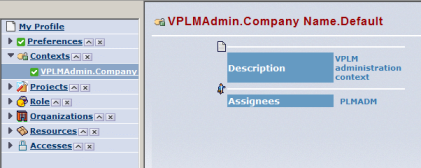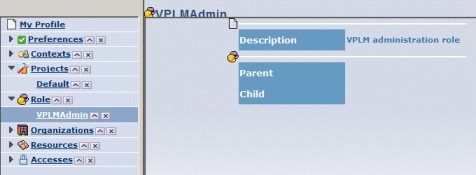My Profile Command Reference Information | ||
| ||
| Node | Description |
|---|---|
| Preferences | Displays user preferences like site and preferred security context |
| Contexts | Base node for user's security context list |
| Projects | Base node for the user's project list (associated through the security context list) |
| Role | Base node for the user's role list (associated through the security context list) |
| Organizations | Base node for the user's organization list (associated through the security contexts list) |
| Resources | Base node for the user's resource list: settings, PRM, applications and design tables |
| Accesses | Base node for the user's accesses: policies, rules, VPLM commands and VPLM masks |
| Symbol | Node | Sub-Node | Description |
|---|---|---|---|
| My Profile | Preferences, Contexts, Projects, Roles, Organizations, resources, accesses | The current user identity card:
|
|
| Preferences | Site, Security Context | The current user’s site and preferred security context | |
| Sites | The current user’s site site | ||
| Security Context | The current user’s preferred security context | ||
| Contexts | List of contexts | Help about Security Contexts | |
| A Security Context | - | Context's assignees | |
| Projects | List of projects (through contexts) | Help about Projects | |
| A project | Resources (settings, etc.) and sub-projects (if any) | Project's information:
|
|
| Settings | Reference, user settings | Help about settings | |
| Reference | - | The list of the project's reference settings (administration settings) | |
| User | - | The list of the current user's settings in this project | |
| PRM | - | The list of PRM (Project Resources Management) resources associated to this project | |
| Roles | List of roles (through contexts) | Help about roles | |
| A role | Sub-roles (if any) | Role's information:
|
|
| Organizations | List of organizations (through contexts) | Help about organizations | |
| An organization | Sub-organizations (if any) | Organization's information:
|
|
| Resources | Help about resources | ||
| Settings | Reference, user settings | Help about settings | |
| Reference | List of projects | Help about reference settings | |
| A project | - | List of the project's reference settings (administration settings) | |
| User | List of projects | Help about the current user's settings | |
| A project | - | List of the current user's settings in this project | |
| PRM | - | List of PRM (Project Resources Management) resources | |
| A project | - | List of PRM (Project Resources Management) resources associated to this project | |
| Accesses | Policies, rules, commands and masks | Help about accesses | |
| Policies | - | The report about accesses granted to the current user in policies | |
| Rules | - | The report about accesses granted to the current user in rules | |
| Commands | - | The report about accesses granted to the current user in VPLM commands | |
| Masks | - | The report about accesses granted to the current user in VPLM masks |
Preferences
This sections explains preferences.
Site
Displays the current user’s site with associated locations (stores). Note that a site has to be created separately: it is not created by default at installation.
The current user's site can be modified using the combo, which contains the list of all available sites. Selecting a site modifies the current user's site.

Security Context
Displays the list of security contexts to which the current user is assigned, enabling you to select your preferred security context. For detailed information about the preferred security context, refer to "What Is the Security Context?".
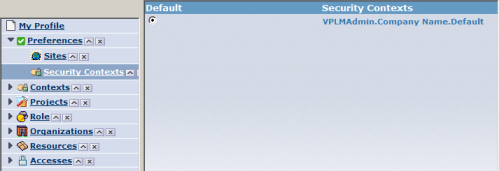
To set the preferred security context, click the appropriate button and click the Update button.
![]()
Projects
Displays the project's basic information (description, parent project and sub-projects):
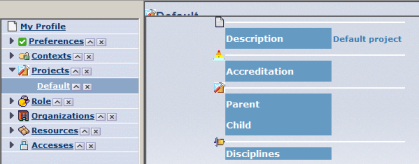
Note: Project settings and PRM resources are not supported in this release.
![]()
Organizations
Displays basic information about the organization (description, parent organization and sub-organizations):
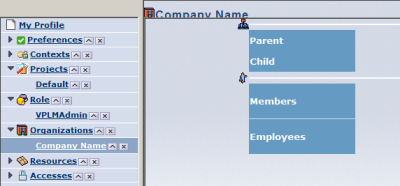
![]()
Accesses
Displays information about:
- policies
- rules
- commands
- masks.
Policies
Generates a report about the policies granted to the user via one of components of the user profile (person, context, public, or one of the context's components: role, project, organization).
The report comprises two parts:
- a filter bar, to filter the elements to display in the report, according to specified criteria
- the report itself, with three main sections: person, context and public.
When the ![]() icon is displayed, this means that there is security information associated to the section and that the section can be expanded by clicking the “+” icon to display the following policy-related information:
icon is displayed, this means that there is security information associated to the section and that the section can be expanded by clicking the “+” icon to display the following policy-related information:
- policy name
- policy state
- accesses (for the secured function) and any associated filters.
By default, when you expand the different sections after a default installation, the following is displayed (not all nodes of the section have been expanded):
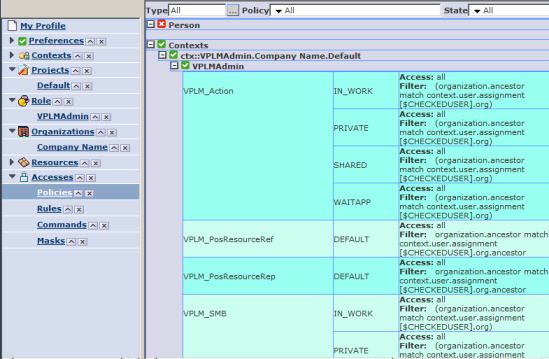
The filter bar is located at the top of the window. It allows you to filter the list of policies displayed according to the following criteria:
- PLM type: use the PLM type filter to list the policies governing the PLM types you selected.
- policy name: filter via policy name
- policy state: filter via policy state
- filter by accesses granted by the policy.
For example, click on the arrow icon next to Policy , uncheck the All option, then select policies VPLM_SMB and VPLM_SMB_PORT_CX, then click the arrow again to confirm your selection.
Note: The All option is selected by default. It must be deselected to use other options.
Finally, generate the report using the Report button. Icons on main sections are recomputed, and the report is updated:
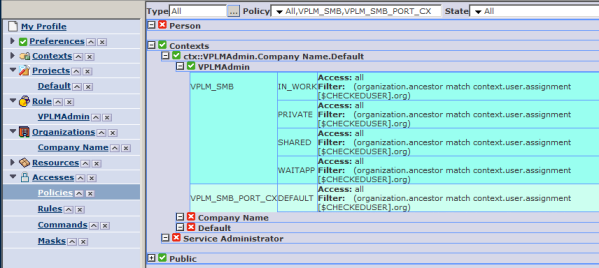
Rules
Generates a report about rules granted to the user via one of components of the user profile (person, context, public, or one of the context's components: role, project, organization).
The user interaface is the same as for policies, except that in this case, the filter criteria are:
- relation type
- rule name
- rule accesses
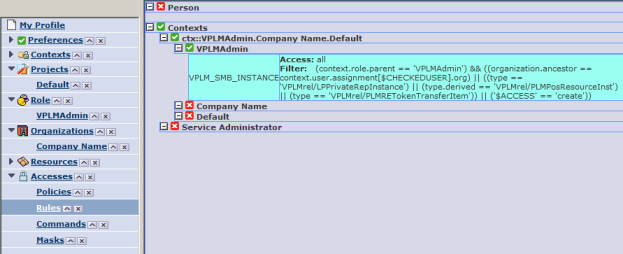
Commands
Generates a report about commands granted to the user via one of components of the user profile (person, context, public, or one of the context's components: role, project, organization).
The user interaface is the same as for policies and rules, except that only commands are filtered.
The following example shows the list of commands for the current user (logged on as PLMADM), showing the public commands for everybody and the commands reserved for use by the VPLM administrator:
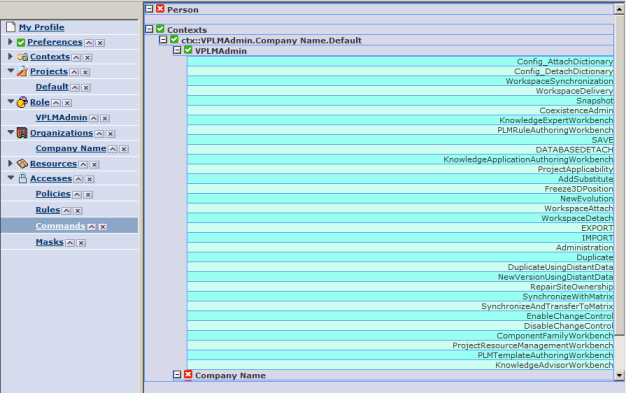
Masks
Masks have a specific behaviour.
Like commands, accesses are limited to the first level of parents of the context.
But the chosen mask depends on the context currently selected at logon, and as only one mask can be chosen for the session, rules of precedence are applied: person first, then context, role, project and organization. If no mask is granted, the "DEFAULT" mask (which is not defined in the DB) is applied.
